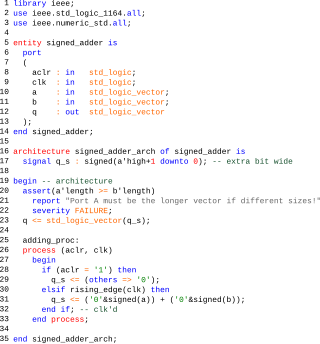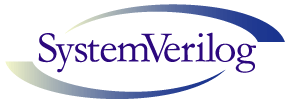
A field-programmable gate array (FPGA) is a type of integrated circuit that can be programmed or reprogrammed after manufacturing. It consists of an array of programmable logic blocks and interconnects that can be configured to perform various digital functions. FPGAs are commonly used in applications where flexibility, speed, and parallel processing capabilities are required, such as in telecommunications, automotive, aerospace, and industrial sectors.

The VHSIC Hardware Description Language (VHDL) is a hardware description language (HDL) that can model the behavior and structure of digital systems at multiple levels of abstraction, ranging from the system level down to that of logic gates, for design entry, documentation, and verification purposes. Since 1987, VHDL has been standardized by the Institute of Electrical and Electronics Engineers (IEEE) as IEEE Std 1076; the latest version of which is IEEE Std 1076-2019. To model analog and mixed-signal systems, an IEEE-standardized HDL based on VHDL called VHDL-AMS has been developed.
Verilog, standardized as IEEE 1364, is a hardware description language (HDL) used to model electronic systems. It is most commonly used in the design and verification of digital circuits at the register-transfer level of abstraction. It is also used in the verification of analog circuits and mixed-signal circuits, as well as in the design of genetic circuits. In 2009, the Verilog standard was merged into the SystemVerilog standard, creating IEEE Standard 1800-2009. Since then, Verilog has been officially part of the SystemVerilog language. The current version is IEEE standard 1800-2023.

A programmable logic device (PLD) is an electronic component used to build reconfigurable digital circuits. Unlike digital logic constructed using discrete logic gates with fixed functions, the function of a PLD is undefined at the time of manufacture. Before the PLD can be used in a circuit it must be programmed to implement the desired function. Compared to fixed logic devices, programmable logic devices simplify the design of complex logic and may offer superior performance. Unlike for microprocessors, programming a PLD changes the connections made between the gates in the device.
In computer engineering, a hardware description language (HDL) is a specialized computer language used to describe the structure and behavior of electronic circuits, most commonly to design ASICs and program FPGAs.
The IEEE 1164 standard is a technical standard published by the IEEE in 1993. It describes the definitions of logic values to be used in electronic design automation, for the VHDL hardware description language. It was sponsored by the Design Automation Standards Committee of the Institute of Electrical and Electronics Engineers (IEEE). The standardization effort was based on the donation of the Synopsys MVL-9 type declaration.

Programmable Array Logic (PAL) is a family of programmable logic device semiconductors used to implement logic functions in digital circuits introduced by Monolithic Memories, Inc. (MMI) in March 1978. MMI obtained a registered trademark on the term PAL for use in "Programmable Semiconductor Logic Circuits". The trademark is currently held by Lattice Semiconductor.
In digital circuit design, register-transfer level (RTL) is a design abstraction which models a synchronous digital circuit in terms of the flow of digital signals (data) between hardware registers, and the logical operations performed on those signals.

A complex programmable logic device (CPLD) is a programmable logic device with complexity between that of PALs and FPGAs, and architectural features of both. The main building block of the CPLD is a macrocell, which contains logic implementing disjunctive normal form expressions and more specialized logic operations.
In computer engineering, logic synthesis is a process by which an abstract specification of desired circuit behavior, typically at register transfer level (RTL), is turned into a design implementation in terms of logic gates, typically by a computer program called a synthesis tool. Common examples of this process include synthesis of designs specified in hardware description languages, including VHDL and Verilog. Some synthesis tools generate bitstreams for programmable logic devices such as PALs or FPGAs, while others target the creation of ASICs. Logic synthesis is one step in circuit design in the electronic design automation, the others are place and route and verification and validation.

SystemVerilog, standardized as IEEE 1800, is a hardware description and hardware verification language used to model, design, simulate, test and implement electronic systems. SystemVerilog is based on Verilog and some extensions, and since 2008, Verilog is now part of the same IEEE standard. It is commonly used in the semiconductor and electronic design industry as an evolution of Verilog.
PicoBlaze is the designation of a series of three free soft processor cores from Xilinx for use in their FPGA and CPLD products. They are based on an 8-bit RISC architecture and can reach speeds up to 100 MIPS on the Virtex 4 FPGA's family. The processors have an 8-bit address and data port for access to a wide range of peripherals. The license of the cores allows their free use, albeit only on Xilinx devices, and they come with development tools. Third-party tools are available from Mediatronix and others. Also PacoBlaze, a behavioral and device independent implementation of the cores exists and is released under the BSD License. The PauloBlaze is an open source VHDL implementation under the Apache License.
Verilog-AMS is a derivative of the Verilog hardware description language that includes Analog and Mixed-Signal extensions (AMS) in order to define the behavior of analog and mixed-signal systems. It extends the event-based simulator loops of Verilog/SystemVerilog/VHDL, by a continuous-time simulator, which solves the differential equations in analog-domain. Both domains are coupled: analog events can trigger digital actions and vice versa.
Electronic circuit design comprises the analysis and synthesis of electronic circuits.
C to HDL tools convert C language or C-like computer code into a hardware description language (HDL) such as VHDL or Verilog. The converted code can then be synthesized and translated into a hardware device such as a field-programmable gate array. Compared to software, equivalent designs in hardware consume less power and execute faster with lower latency, more parallelism and higher throughput. However, system design and functional verification in a hardware description language can be tedious and time-consuming, so systems engineers often write critical modules in HDL and other modules in a high-level language and synthesize these into HDL through C to HDL or high-level synthesis tools.
Flow to HDL tools and methods convert flow-based system design into a hardware description language (HDL) such as VHDL or Verilog. Typically this is a method of creating designs for field-programmable gate array, application-specific integrated circuit prototyping and digital signal processing (DSP) design. Flow-based system design is well-suited to field-programmable gate array design as it is easier to specify the innate parallelism of the architecture.
Aldec, Inc. is a privately owned electronic design automation company based in Henderson, Nevada that provides software and hardware used in creation and verification of digital designs targeting FPGA and ASIC technologies.
MyHDL is a Python-based hardware description language (HDL).
Catapult C Synthesis, a commercial electronic design automation product of Mentor Graphics, is a high-level synthesis tool, sometimes called algorithmic synthesis or ESL synthesis. Catapult C takes ANSI C/C++ and SystemC inputs and generates register transfer level (RTL) code targeted to FPGAs and ASICs.
The following outline is provided as an overview of and topical guide to electronics:





